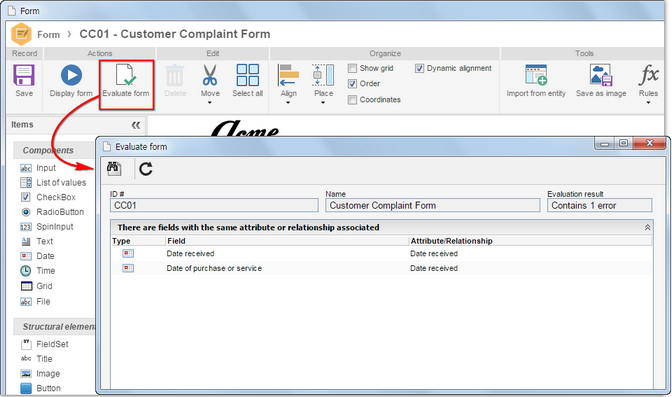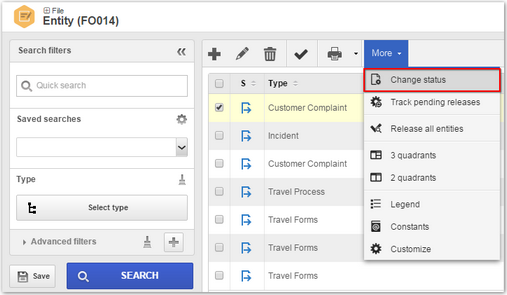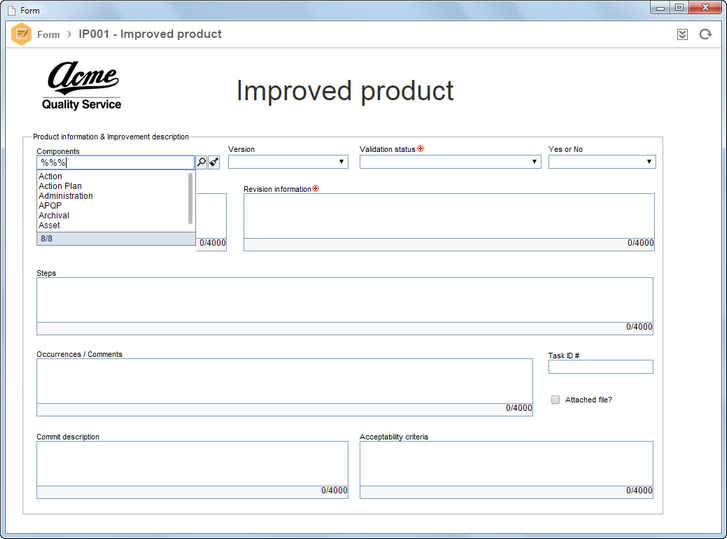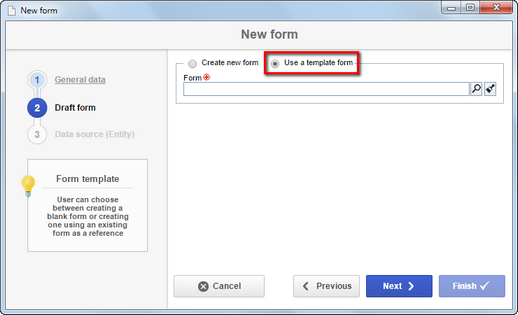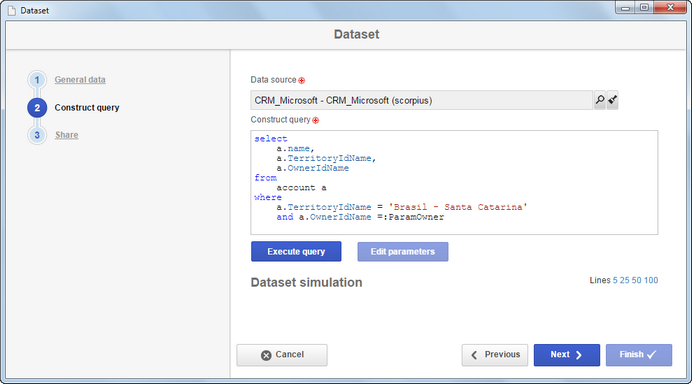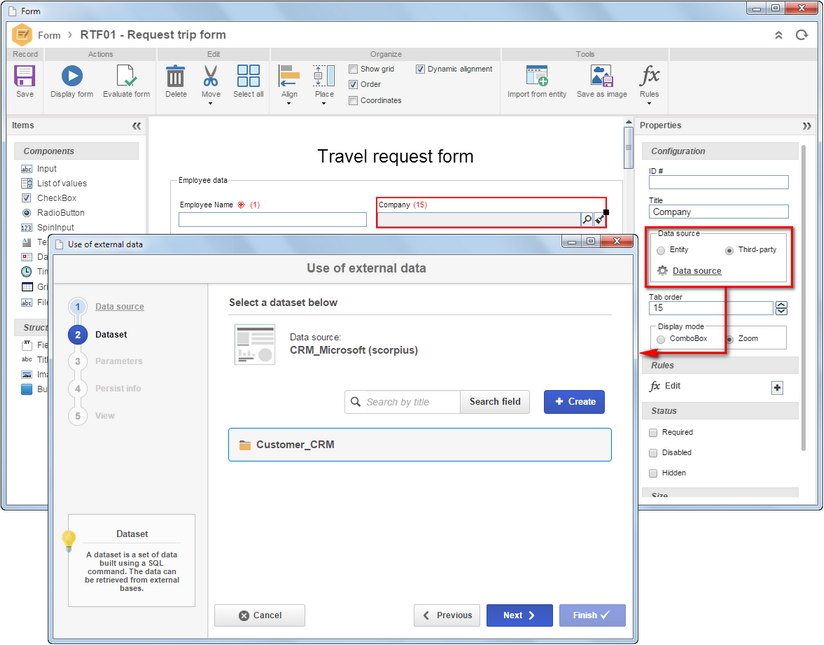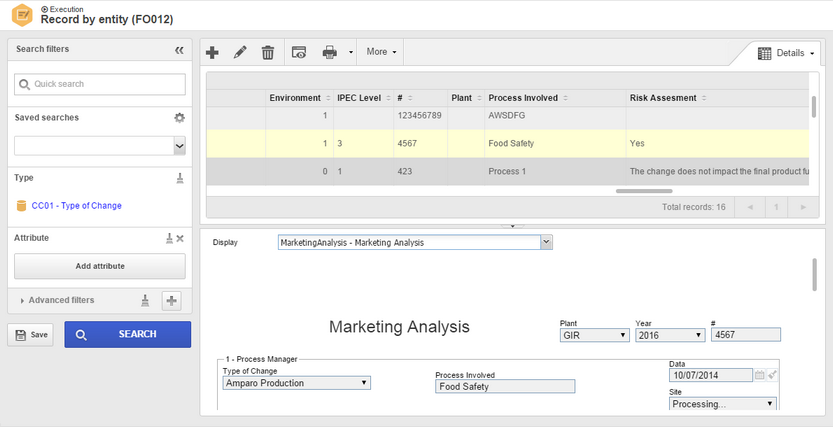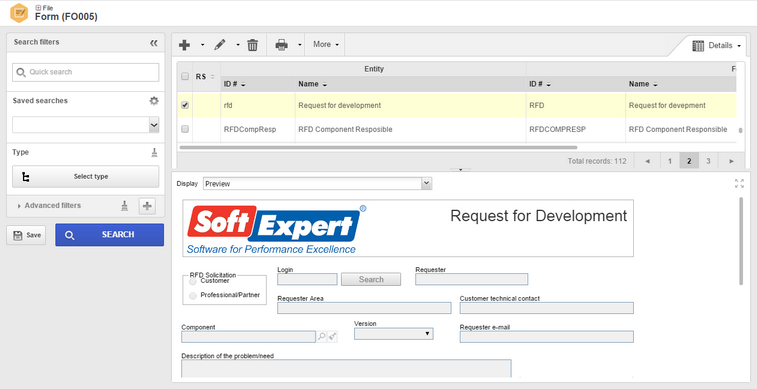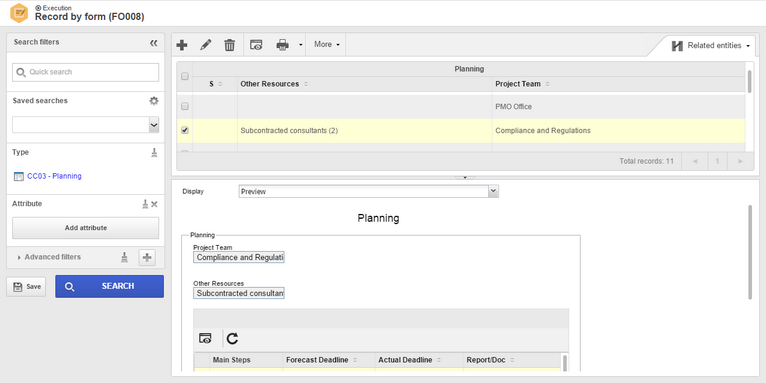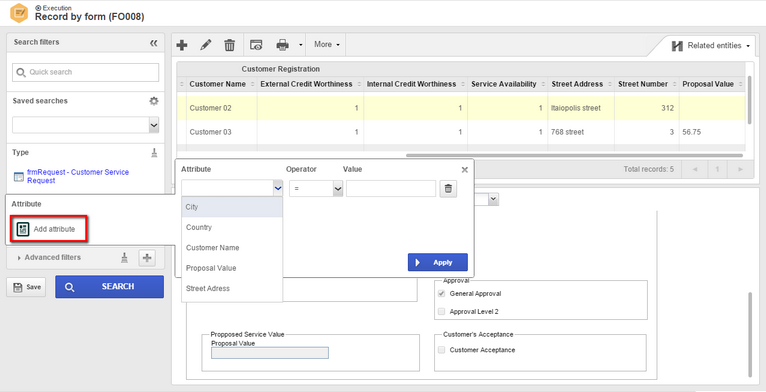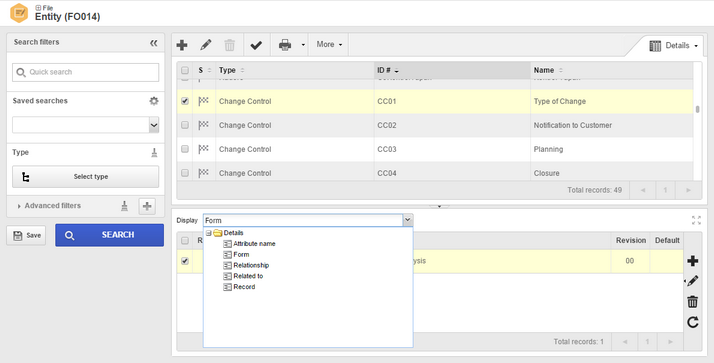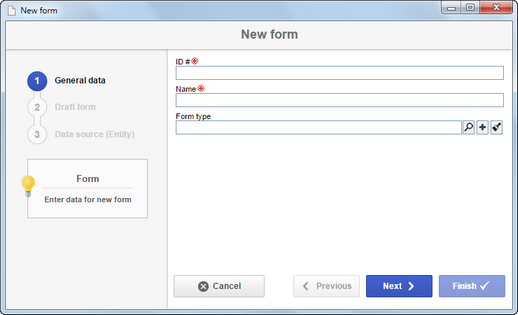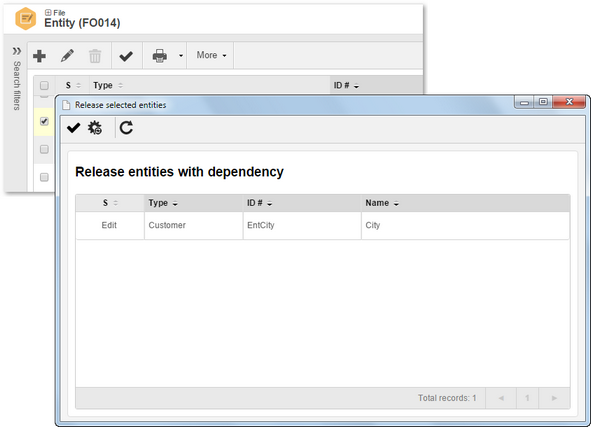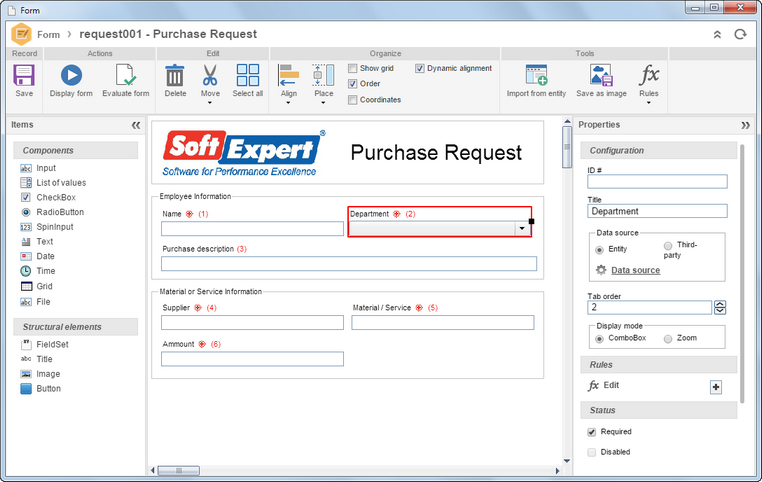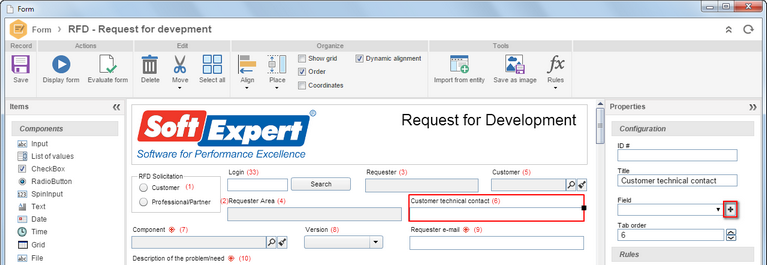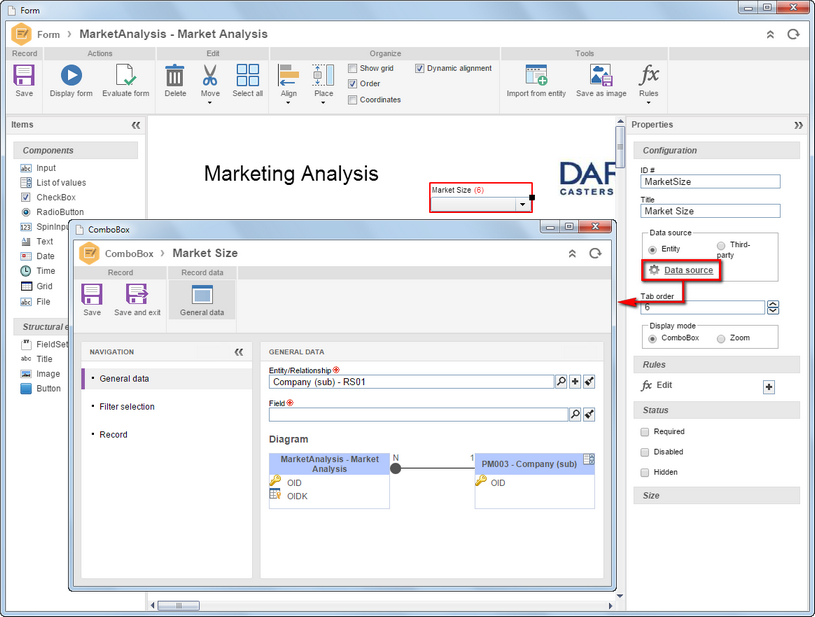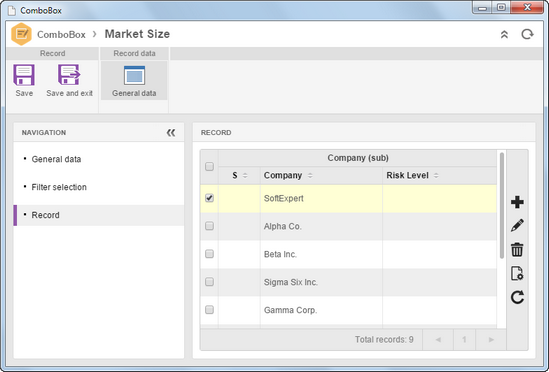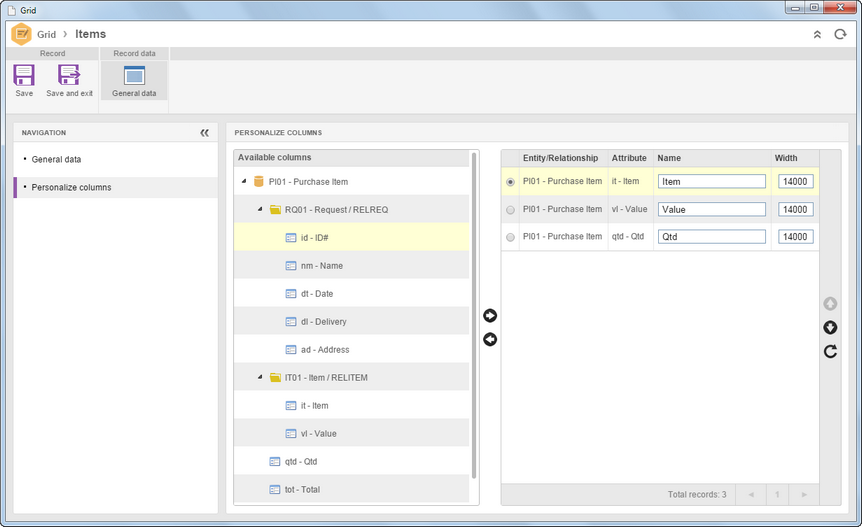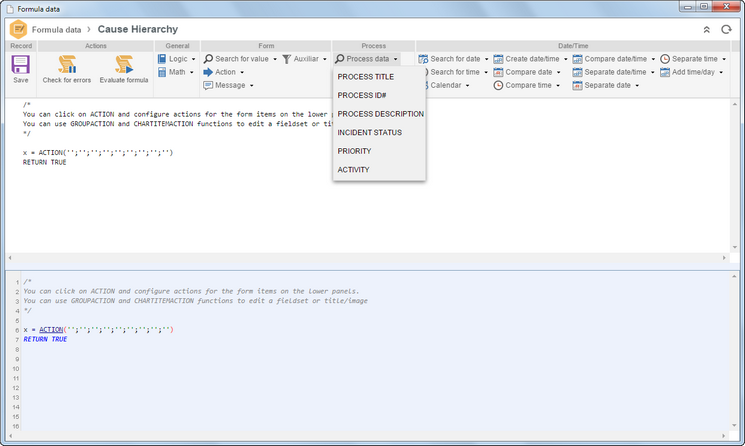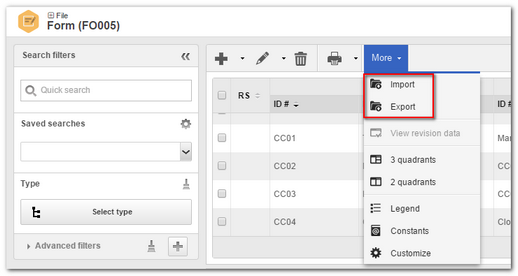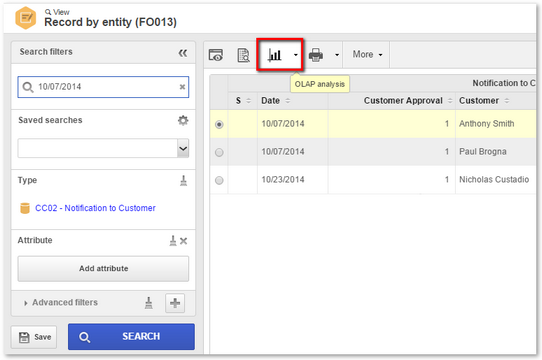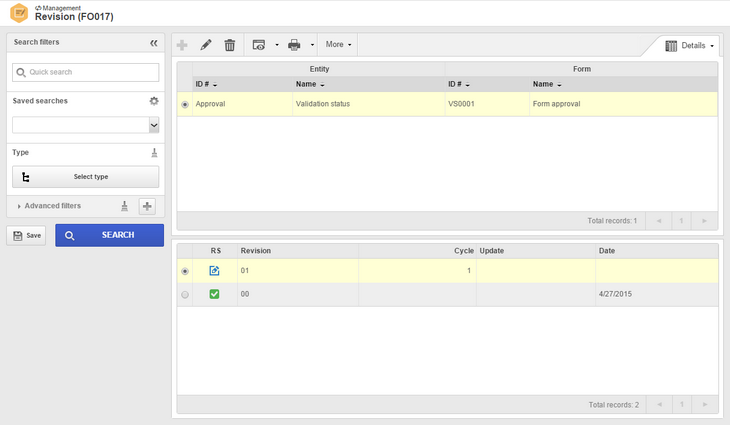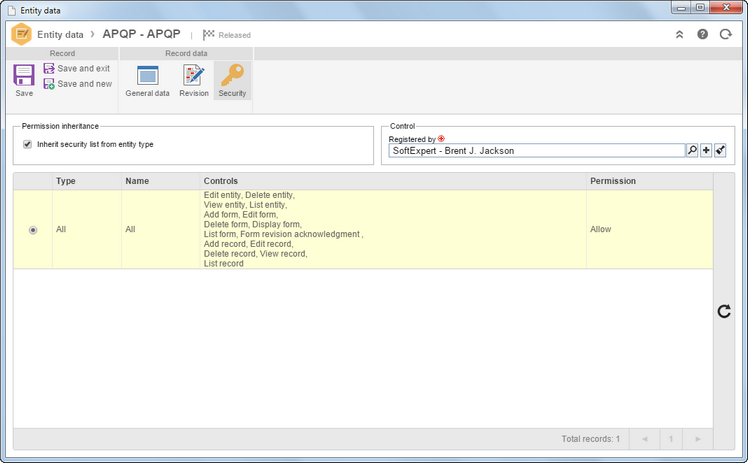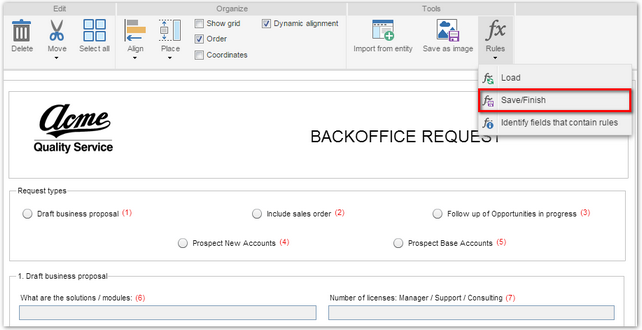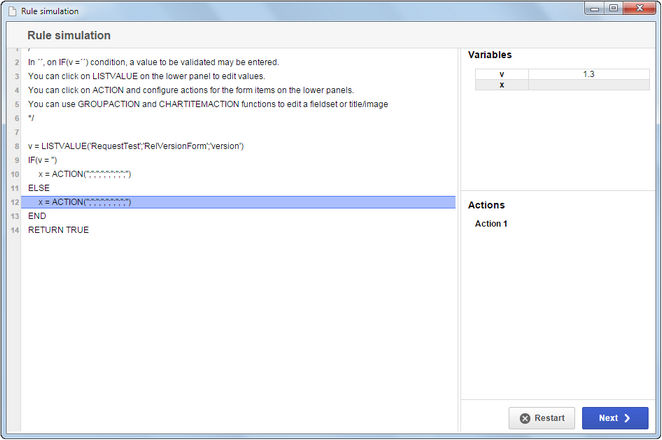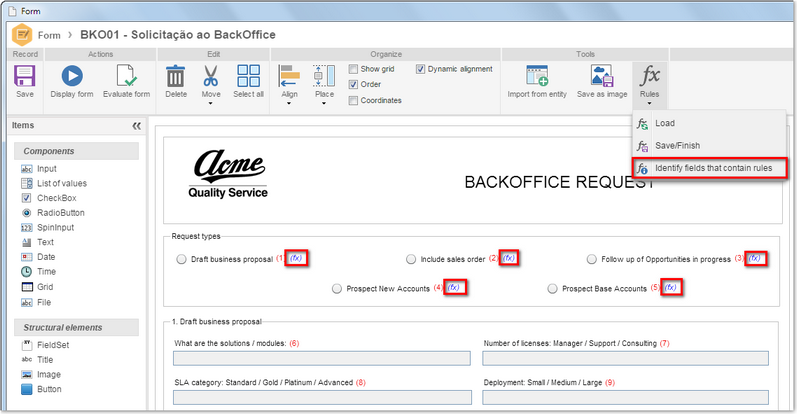
N-N relationship Search fields
A new functionality that allows to create search fields among value lists with N-N relationships was developed (multiple associated records). This allows for example, the use of "User" and "Department" fields. A "User" can be in several departments as well as a "Department" has several "Users".
Zoom type List of values field
A new type of list of values was created, which allows to open a screen to select the record. This resource is usually used in SE Suite.
Verify inconsistencies in the form
A functionality was created to verify possible errors during the process to create the form. This validation checks inconsistencies such as: Association of fields with attributes, filling out field relationship, selection of mandatory fields, relationships, filling out title, size of "Grids" (table) column, fields that have the same attribute or relationship and use of attributes that are disabled or under revision. This improvement enables manager better control of form changes. Such verification can be performed through [Evaluate form]button, located on the toolbar (ribbon) of form modeler.
Enable/disable record
A new resource was created, to disable records that should not be displayed when new items are recorded. That improvement allows form manager to easily disable old or obsolete records. To disable a record, user should access record execution menu by entity, search desired record and click on "Change status" button.
Conversion to HTML
A rendering resource was created to execute form and which has a new interface, for better performance and use. Uses loading on demand resources, maximizing performance and improving end user perception. HTML form presents a method to design an interface that allows to hide sections and adjust forms automatically, avoiding gaps between items and offering high quality applications to end user. The new interface also offers smart typing in zoom type list of values, providing to the end user a flash fill option for a better experience. That functionality is also available in 1.3 version, through the execution of a parameterization command in the database.
When a fieldset is hidden through a formula, the rest of the form below goes up to eliminate the gaps
A new formula was created to hide a section of the form and rearrange the items below through artificial intelligence, which performs the procedure and does not need a user. Such resource needs full sections to apply the algorithm, i.e., works using fieldsets. This functionality is part of the improvements of HTML form and is also available in 1.3. version.
New formulas
New formulas were created to allow manipulation of form fields. Manipulation occurs through formulas that allow to hide, display, require, enable, disable, etc., according to specific information of Form components. Some examples are: functions to calculate date and time, calculate total in a form table and execute commands to search values in SE Suite database. Some actions were also created to enable and disable fields within a grouper. Hide and display graphic elements such as: title, image and fieldsets. Some examples.
Form copy
A new functionality was developed, which allows to create a form copying the data of another existing form. To satisfy such need, a registration screen was developed using a wizard to reach a more intuitive registration during the configuration of information, detailed step by step. If copied form belongs to the same entity, all data is copied. If entities are different, only the layout is copied. Form templates can also be created applying that improvement.
Integration with external entities
To allow access to information from external databases, a new functionality was made available in SE Form. External databases can be accessed through datasets that are also used to display values in a list of values, such as CRM customers. It is also possible to configure the system to search values when user clicks a button. The system searches and fills out the form fields.
An intuitive screen was developed to create a dataset. Such screen requests necessary information following a step by step process. In one of the steps, user enters the SQL to retrieve the values from the external database. The command may be simulated on the same screen, simplifying building process.
It is also possible to configure the parameters used to filter data. The value for each parameter can come from a form field, such as for example, search all customers from a specific area that is also filled in the form.
To use external lists of values, new components to drag and drop in the form design have been made available in the form modeler. New components are placed on the left side of the Dataset panel. The creation and configuration of datasets can also be accessed in the form property panel, enabling creation and configuration without needing to exit form modeler.
SE Form integrated with SE Project
A new integration resource was created, to allow to fill out information in a form of SE Form component, during the execution of an activity. To associate forms with a project activity, an association grid has been made available in the activity data, accessed by SE Gantt Chart. To fill out the form during the execution of the project, an execution grid was also created and is available in the task.
Functionality: Form type
A new classification for forms has been created, which allows to create form types to group several forms of different entities. E.g.: Trip process forms.
New views
To improve the information displayed on the third quadrant and which is related to the selected form, SE Form now offers through a combo on the toolbar that separates the second and third quadrants, data options that refer to form registration. According to the selected item, the system will display information on the third quadrant. Besides the changes made to the way information is displayed on third quadrant screen, the "Entity" registration screen was also modified, so that it follows the same standard used for the other programs of SE Suite with "General, Details, Form and Security" tab screens.
File/view menu by form
Besides entity registration, user can also create and view forms through a specific menu. User can search by entity or form type (new classification for 2.0). On the third quadrant of this menu, user can see a preview of form design. The system also shows in which components the form objects are associated and allow a more complete management.
Menu of records by form execution/view
New menu created to add, edit and delete records of entities. Through this menu user can search the forms directly and does not need to know the entity the forms belong to. You can also search by form fields, which allows to quickly and accurately find records. User can also browse through the records and see the filled form in the lower panel, with fewer clicks and making the search simple and straightforward. User can also open the Analytics through that search. The cube that has been generated can be saved for new searches and be published in SE Suite portals. Thus, significant search can be customized and easily published for everyone.
Functionality: View records using the entity attributes as filters
Now user can filter records of the entities through the fields, being able to quickly locate desired records. User can choose to search records through entity or form.
Improvement of third quadrant
On the third quadrant of entity registration, user can now view the form list (SE Suite 1.3) as well as the entity attributes, relationships, related entities and records. After that improvement, user will be able to add/edit attributes and relationships and add records to the entity in the same menu. User can also browse through the records of the entity and see the data on the third quadrant. This will allow user complete analysis and management, with easy access.
New screen to create form
A new screen was created, to create a form using a wizard. This screen has a procedure explained step by step, that allows to reduce complexity and makes the creation process faster and intuitive.
Improvement for entity release
Improvement to release entities, that displays a list of the entities to be released. The result is higher control of releases and changes in related entities.
New screen of form modeler
To build form quickly and easily, the screen of form modeler was reformulated. New toolbar (ribbon) and property panels assist to make form creation simple. Significant improvements related to use facilitate understanding of information in the property panel. Shortcuts were implemented to create fields and screens that contain step by step instructions, to help configure the properties of each fields in an intuitive way. Performance was also improved to allow to save the forms and to load them quickly.
Attribute of entity can be created from the form editor
The form editor allows user to create fields in the entity, not needing to exit the screen. The new interface of properties panel considers the creation and use of entity attributes, allowing to release the entity only when the form is finished. In 1.3 version, user had to release the entity every time he wished to create attributes to be used in the form. The creation of attributes has been simplified in 2.0 version. The system filters data types (text, number, etc.) according to the form field (input, checkbox, etc.) and this facilitates his chore.
Create new N-1 relationship from form editor
A new screen was created to configure the data of a list of values (combobox/zoom); this screen allows to create relationships in case they have not been created yet. The relationship data screen still has a simplified MER that displays the relationship between the two entities and the foreign key. Such information can be used to simplify the creation or modification of customized cubes from SE Analytics.
Add record to the combobox/zoom list from the form editor
A tela de dados do relacionamento possui uma seção que permite incluir registros na entidade da lista de valores. Thus, user can create a list (e.g.: City) and quickly and easily insert the records not needing to exit the screen.
New configuration screens for complex items (list of values, grid, etc.)
New screens for combobox, zoom and grid were developed. They allow better use and performance, in configuration screens and when form is loaded and saved.
Insert and Edit records of entities not needing a form
The system creates during modeling, a form where information is displayed in a list (one item below the other), eliminating the need to create forms for single entities.
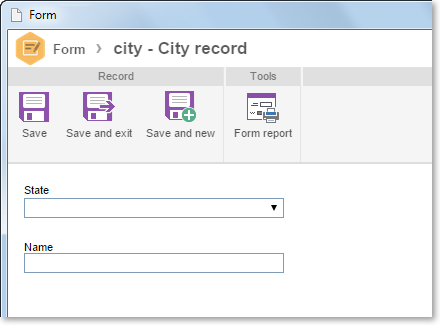
Improvement of formula toolbar
To simplify understanding and use of buttons, a new toolbar interface was created (ribbon) of formula component. This interface allows to organize and group buttons by function, such as: Functions to apply actions, functions to perform searches, to calculate date and time, among others.
Suggestion of formula for each type of form item
When user creates a formula, the system displays an example that contains a condition and action. After that improvement user can decrease learning curve of formula component and also increase productivity during the creation of form rules.
Form export/import
To export and import forms among SE Suite environments, such as Test and production environments, a new functionality was developed. The system exports the data related to the form: Entity type, Form type, Entity, Attributes, relationships, form and form design that contain the relationships of items with entity fields. Using that procedure, besides reuse in test and production environments, user can create templates to help managers parametrize the system.
To be able to use this resource, new buttons are available now to register forms. User should select the form and click on export. The system generates a file that has (*.se) extension. A screen that contains a step by step procedure for import, opens. The system verifies whether the data has already been entered in the database, during each import step. If the data has been entered, the fields on the right side are shown filled and user can choose to keep those values or change them. If the data has not been entered, the fields on the right side are shown empty indicating the system will create the data. This means user will have to choose whether to select another value or let the system create it automatically. After import has been finished, the system opens the form automatically.
Open SE Analytics from record view screen
A new functionality has been created to open SE Analytics from the view of form registration, and entering SQL command is not necessary anymore. Using SE Analytics, user can save the cube for future views and also publish the view in a portal. To open SE Analytics a new button is available in the toolbar. Thus, significant search can be customized and easily published for everyone.
Form revision
To guarantee the best practices for the use of versioning/revision, SE Form allows to configure revision control. The revision follows the standard of SE Suite (ISO, Workflow, Projects). The new version is applied to the users only after release. Thus, user can guarantee full management, keeping history of the changes that have been made.
Security of entities, forms and records
A new functionality was developed, which allows to define access controls for the entities, forms and records. Some of these controls are: edit, delete, view and list. Controls can also be defined for 'Form revision acknowledgment'. The model follows the standard of SE Suite, that is, access is defined in type and the entity can inherit it from its category or define its own security. User can also restrict access to data of entity type.
File type field
A new component in the form modeler was created, which allows to attach files and images directly to the form body. If the file is an image, it can also be used in the form body. To create a file field in the form, user should create a file type attribute in the entity. This procedure is similar for the other form fields. To display the image in the form body, user should select the same entity attribute in both fields: file and image.
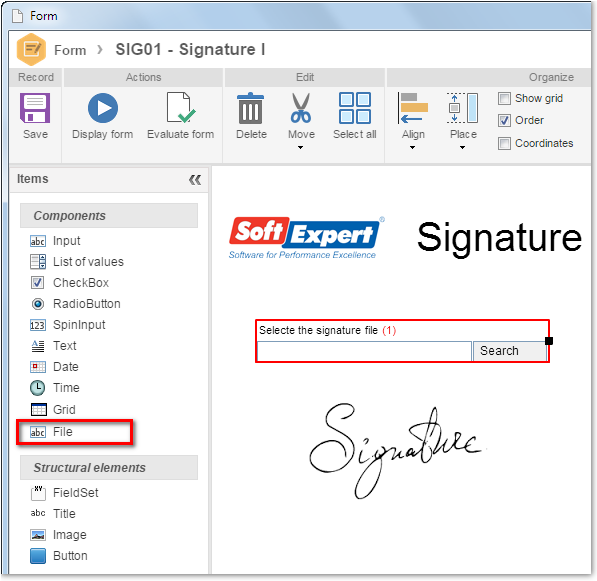
Executed formula when user saves the form
A new event was created that is triggered when user saves a form. Thus, user can perform validations in filled values. The system still considers formula through workfow action described in SE Process document.
Simulation of formulas performed line by line
A new resource was created to simulate a formula, which allows user to validate the rule logic in an intuitive, simple and quick way. The system opens a screen that allows to execute the formula line by line. The values are displayed on the panels placed on the right side, with the result.
Show identification in the fields that have rules/formulas
For better use and to facilitate the identification of the fields that have formulas, there is a new button on the toolbar (ribbon) of form modeler. This button shows a sign to indicate if the fields have a rule. Consequently, user can manage rules quickly and objectively.
